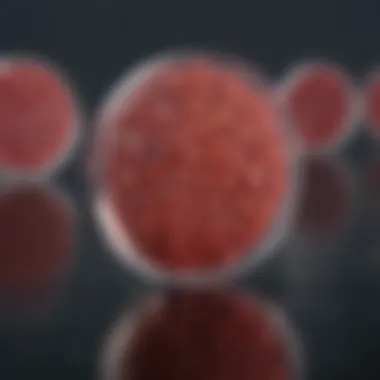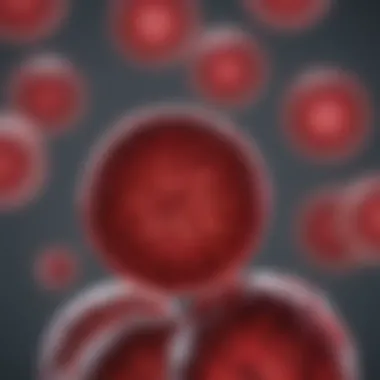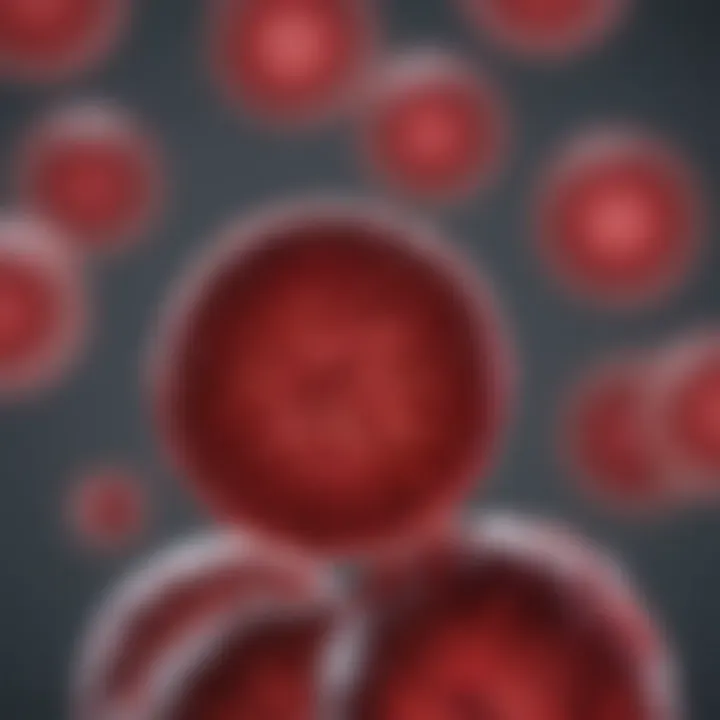Comprehensive Guide to Ebioscience RBC Lysis Buffer


Intro
Ebioscience RBC lysis buffer is a vital reagent in the field of biological science, particularly in hematology and cell biology. This solution is primarily used for the lysis, or breakdown, of red blood cells to isolate other cellular components for analysis. By obtaining a pure sample of white blood cells or other cell types, scientists can perform various tests and analyses that demand high precision and specificity.
The applications of RBC lysis buffer extend beyond mere cell isolation. It plays a crucial role in many laboratory techniques, including flow cytometry, immunophenotyping, and even large-scale cell culture experiments. In this introduction, we will highlight the importance of understanding the composition, mechanisms, and protocols associated with the use of Ebioscience RBC lysis buffer, setting the stage for a deeper exploration of its various applications and intricacies.
Furthermore, the significance of this reagent lies in its ability to enhance the accuracy of experimental outcomes, making it indispensable for research, clinical diagnostics, and therapeutic developments. It’s more than just a simple solution; it's a foundational tool in modern biological research.
This article aims to provide a holistic understanding of the subject, diving into methodological approaches that researchers employ, along with current trends shaping its application. Limitations and considerations will also be discussed, outfitting readers with the knowledge needed to take full advantage of this essential buffer in their laboratory practices.
Preface to RBC Lysis Buffers
RBC lysis buffers are integral components in various biological and medical research areas. They serve the primary function of lysing red blood cells, which is crucial for numerous applications ranging from routine hematology to advanced flow cytometry analyses. Understanding how and why these buffers function is essential to ensuring accurate results and maintaining integrity throughout various experimental procedures. This section seeks to provide an insight into these buffers and the context in which they are used, making the material accessible and relatable for students, researchers, and professionals alike.
Defining RBC Lysis Buffers
RBC lysis buffers are solutions specifically designed to disrupt the cell membrane of red blood cells, leading to the release of hemoglobin and other intracellular components into the surrounding medium. These buffers typically consist of a range of salts, detergents, and sometimes specific reagents that create optimal conditions for lysis. The presence of these components is essential, as they not only facilitate the lysis process but also help to stabilize the released biomolecules. Such stabilization is necessary for downstream applications that analyze cellular components post-lysis.
When we break things down, most lysis buffers work by altering the osmotic pressure or disrupting the lipid bilayer of the cell membrane. This results in a cellular rupture that allows for easier access to the contents of the cell. In a variety of methods, the composition may contain phosphate-buffered saline (PBS) or Tris buffer, which are common pH buffers, along with additional agents like ammonium chloride or EDTA to further enhance their effect. The final objective is to extract cellular material while preserving the quality and integrity of analytes for subsequent experimentation.
Historical Context
The journey of RBC lysis buffers isn’t just a scientific one; it’s steeped in the evolution of laboratory techniques throughout the 20th century. The initial understanding of red blood cell behavior came about with the foundation of cell biology itself. Early hematology utilized simplistic methods to separate blood components, often relying solely on gravity and centrifugation. However, as the demand for more precise analyses grew, so did the complexity of the tools needed.
In the mid-1900s, researchers began to recognize the limitations of traditional methods, particularly when dealing with mixed cell populations. It was during this time that RBC lysis buffers entered the scene, brought forth by the incessant demand for enhanced separation techniques. Innovations in biochemistry allowed scientists to craft specialized buffers that could selectively lyse red blood cells without affecting other cellular elements, marking a turning point in cellular bioscience.
"The advent of RBC lysis buffers revolutionized cell biology, turning tedious and inaccurate methods into streamlined, efficient processes."
Over the years, these buffers have gone through significant refinements, leading to the modern protocols now widely used in research and clinical applications. The historical evolution of these buffers highlights not only advancements in scientific understanding but also the endless need for innovation in response to laboratory needs. Today, as we delve into the specifics of Ebioscience RBC lysis buffer, we appreciate this legacy and its importance in shaping contemporary research methodologies.
The Science Behind Ebioscience RBC Lysis Buffers
When diving into the intricate world of laboratory practices, the science behind Ebioscience RBC lysis buffers emerges as a cornerstone of many biological assessments. This section scrutinizes the key components that underpin the buffer's design. Understanding these scientific principles enhances the effectiveness of research endeavors and enables practitioners to make informed decisions when utilizing this reagent.
Chemical Composition
The chemical composition of Ebioscience RBC lysis buffer is not merely a string of ingredients; it is a carefully orchestrated blend designed to perform specific functions. One might think of it like a chef assembling a dish, where each ingredient, from sodium chloride to pH stabilizers, plays a unique role.
- Sodium Chloride (NaCl): This common salt is critical for maintaining osmotic balance. Its presence helps to create an isotonic environment, preventing unwanted cell lysis until ready.
- Buffers (such as HEPES or phosphate): These components stabilize the pH of the solution, ensuring that enzymatic activities are maintained during cell lysis. Variations in pH can lead to erratic results or even compromise the integrity of cellular components.
- Surfactants (like Triton X-100): These act like tiny detergents, disrupting lipid membranes. By doing so, they facilitate the release of red blood cells from their confines without damaging other cellular constituents. This selective lysis is pivotal in studies where only specific cell types are examined.
- Chelators (such as EDTA): These elements bind divalent cations like calcium and magnesium. By doing so, they prevent cellular-level reactions that can interfere with downstream analyses, such as flow cytometry.
- Water (preferably deionized): As the solvent, it serves as the medium that allows other components to interact effectively. Purity here matters more than one might think; any impurities can drastically alter the buffer's effectiveness.
In summary, the careful selection of these components ensures that the Ebioscience RBC lysis buffer effectively lyses red blood cells while preserving analytical integrity.
Mechanism of Action
Understanding the mechanism of action behind the Ebioscience RBC lysis buffer offers crucial insights into how it achieves its objective: to separate cells effectively without causing chaos in the sample. When red blood cells are exposed to this buffer, several key physiological and biochemical reactions unfold.
- Osmotic Pressure: Initially, the sodium chloride helps maintain osmotic pressure, creating a balance that is crucial for maintaining cell structure until the lysis process is initiated. This gradual shift this minimizes shocks that might lead to unintended cellular damage.
- Membrane Disruption: Once the buffer's action begins, surfactants effectively disrupt the phospholipid bilayer of the erythrocytes. Think of this step as the lifeguard diving in to open up a jam-packed beach; it creates the needed space for essential cellular components to escape without burst into chaos.
- Cation Chelation: The presence of chelators proves vital, as they sequestrate important cations that stabilize cell membranes. With these cations in check, the RBC membranes are weakened, allowing for a more controlled lysis.
- Cell Component Release: Ultimately, lysis occurs, liberating hemoglobin and other cellular components into the solution while ensuring that other cell types remain unscathed. This selective action is what makes the buffer so valuable in clinical settings and experimental protocols alike.
Preparation of Ebioscience RBC Lysis Buffer
The process of preparing Ebioscience RBC lysis buffer is crucial for numerous laboratory applications. This buffer acts as a critical agent in the manipulation and analysis of red blood cells. It is designed to facilitate the lysis, or breaking apart, of red blood cells, allowing researchers to work with the resulting components in their studies.


The importance of meticulous preparation can’t be overstated. A well-prepared lysis buffer enhances the accuracy of experimental results, thereby enabling reliable data collection. Furthermore, improper preparation can lead to unreliable results, wasted resources, and could even compromise entire experiments. This section will break down everything you need to know about the preparation process, the materials needed, and a step-by-step protocol for successful implementation.
Required Materials
When preparing Ebioscience RBC lysis buffer, there are specific materials you must gather to ensure a smooth and effective protocol. The materials typically include:
- Ebioscience RBC Lysis Buffer: Ensure you have the specific product for consistency.
- Distilled Water: It’s essential for diluting and mixing with the buffer.
- Pipettes and Tips: For accurate measurement and transfer of liquids.
- Sterile Tubes: Used for the preparation and storage of the lysis buffer.
- Stirring Rods or Magnetic Stirrer: To mix the solutions thoroughly.
- pH Meter or Strips: To confirm the mixture maintains the intended pH.
Having these materials on hand not only simplifies the procedure but also ensures reliability in your experimental conditions.
Step-by-Step Preparation Protocol
Now that we’ve gathered the requisite materials, let’s delve into the detailed protocol for preparing the lysis buffer. Follow these steps carefully to achieve the desired results:
- Calculate the Required Volume: Determine the amount of buffer needed based on your experimental requirements.
- Measure Distilled Water: Using a pipette, measure the required volume of distilled water accurately.
- Add Lysis Buffer Concentrate: Next, add the appropriate amount of the Ebioscience lysis buffer concentrate to the distilled water. A 1:10 ratio (one part buffer to nine parts water) is commonly used, yet be sure to consult the specific product’s guidelines.
- Mix the Solution: Stir the mixture well using a stirring rod or a magnetic stirrer until the buffer is completely dissolved and uniform.
- Check pH Levels: Use your pH meter or strips to measure the pH of the solution. The ideal pH usually falls between 7.0 to 7.4. Adjust if necessary.
- Transfer to Sterile Tubes: Pour the lysis buffer into sterile tubes for storage. Label each tube with the date of preparation for tracking.
- Storage: Store the lysis buffer at appropriate temperatures, typically 2-8 °C, ensuring its efficacy.
By following these steps, researchers can create a consistent and reliable RBC lysis buffer that is ready for applications in various experimental settings. Each component of this preparation is crucial, and overlooking a detail can lead to significant variations in results.
Accurate preparation of lysis buffer is not just a step in a protocol; it’s a fundamental part of achieving reliable experimental outcomes.
Furthermore, always maintain high standards of cleanliness during preparation to avoid contamination. This will ensure the integrity of your research activities. Following this guide meticulously will aid in maximizing the performance of Ebioscience RBC lysis buffer in your laboratory applications.
Applications of RBC Lysis Buffers in Research
RBC lysis buffers serve a crucial role in various research endeavors, particularly in studying cell populations. These buffers are not just solutions; they are integral to isolating red blood cells from whole blood and streamlining the analysis of other cell types, such as white blood cells. This process facilitates a deeper investigation into cellular behaviors, genetic make-up, and interactions that may otherwise go unnoticed. By effectively lysing red blood cells, researchers can better concentrate on their objectives without the interference of abundant RBCs, which are the most numerous cells in blood. Understanding and mastering the applications of RBC lysis buffers can drive significant advances in hematology and broader clinical research.
Utilization in Hematology
In the realm of hematology, the utilization of RBC lysis buffers is paramount. Hematologists use these buffers to analyze blood components efficiently. A primary application is in tests for hemoglobinopathy or assessing disorders like thalassemia and sickle cell disease. For instance, varying hemoglobin types can be distinguished when the RBCs are lysed; the buffer allows for a clear focus on the remaining components in a blood sample.
Utilizing Ebioscience RBC lysis buffers in this context offers several advantages:
- Enhanced Clarity: The buffer clears out RBC debris, allowing hematologists to visualize and count white blood cells or platelets more accurately.
- Specific Targeting: With the right lysis buffer, specific sub-populations of cells can be isolated, enabling focused studies on those with specific diseases or conditions.
- Quantitative Analysis: By providing a clean sample, researchers can conduct precise quantitative analyses of cells, which is essential for diagnosing hematological disorders.
Hematology further benefits from the lysis buffers in the context of blood transfusion medicine. Incompatibility tests and crossmatch procedures rely on RBC lysis to prevent hemolytic reactions, which can dramatically affect patient outcomes. Thus, it’s critical for professionals in the field to recognize the importance of proper RBC lysis buffer use.
Role in Flow Cytometry
Flow cytometry is another field where RBC lysis buffers find their niche. Flow cytometry enables the analysis of physical and chemical characteristics of cells or particles in a fluid as they pass through at least one laser. The presence of intact red blood cells can skew results, giving rise to inaccurate data. Hence, RBC lysis buffers like those from Ebioscience are indispensable in this analytical technique.
Here’s how RBC lysis buffers enhance flow cytometry:
- Improved Data Precision: By lysing RBCs, researchers obtain a sample free of clutter. This improves data resolution and allows for more accurate gating of cell populations.
- Multiparametric Analysis: With RBCs cleared from the mix, it’s easier to utilize multiple fluorescent markers, enhancing the capabilities of flow cytometry to distinguish between various cell types simultaneously.
- Time Efficiency: Using the lysis buffer streamlines the workflow, reducing the setup time for flow cytometric assays. This efficiency can be vital in high-throughput research settings.
Reading through these applications, it’s clear that RBC lysis buffers are not just supplementary reagents; they are essential tools for accurate, robust scientific inquiry. Their effective use continues to push the boundaries of what is understood in cell biology and clinical practice.
Ebioscience RBC Lysis Buffer in Clinical Settings
Ebioscience RBC lysis buffer plays a critical role in clinical settings, particularly when it comes to the analysis of blood samples. In these environments, the extraction of cellular components is vital for accurate diagnostic procedures. By removing red blood cells, clinicians can focus on other important elements such as white blood cells and platelets, enhancing the precision of various tests. This section will delve into the potential diagnostic applications and real-world case studies that highlight the relevance of Ebioscience RBC lysis buffer in clinical practice.
Potential Diagnostic Applications
The use of Ebioscience RBC lysis buffer extends across multiple diagnostic avenues. Here are a few significant applications:


- Flow Cytometry: The buffer helps facilitate the identification and quantification of cells in a sample. It's common in immunophenotyping assays, where specific cell markers are evaluated.
- Molecular Diagnostics: Following the lysis of red blood cells, ground cellular material can be used for downstream applications like PCR and DNA sequencing. This helps in identifying genetic disorders and infectious diseases.
- Hematological Analysis: The buffer aids in preparing blood samples for complete blood counts (CBCs) and differential counts. Accurate measurements can be obtained by eliminating interference from red blood cells.
"The accuracy of blood diagnostics depends heavily on the quality of sample preparation, making RBC lysis buffers indispensable in the clinical realm."
These applications demonstrate how the Ebioscience product enables more precise and efficient proteomic and genomic analyses, thereby reinforcing its significance in clinical diagnostics.
Case Studies
There are numerous instances where the use of Ebioscience RBC lysis buffer has led to impactful diagnostic gains. Here are a couple of notable examples:
- Sickle Cell Disease Testing: In a clinical laboratory, a case involved testing patients for sickle cell disease using flow cytometry. The use of Ebioscience RBC lysis buffer allowed for the straightforward separation of blood cells, significantly improving the assay’s sensitivity in identifying abnormal hemoglobin types.
- Cancer Immunotherapy Monitoring: In another instance, researchers applied RBC lysis buffer to assess immune cell populations in cancer patients undergoing therapy. By removing the interference posed by red blood cells, they could precisely evaluate T-cell responses, aiding in tailoring treatment plans.
These case studies highlight not just the utility of Ebioscience RBC lysis buffer, but also its pivotal role in advancing medical diagnostics and improving patient outcomes.
Considerations for Optimal Use
Utilizing Ebioscience RBC lysis buffer effectively demands a careful approach. The impact of this reagent is vast, spanning several applications in both research and clinical settings. Consequently, understanding the nuances of its use becomes crucial for students, researchers, educators, and professionals. This section discusses how storage conditions and safety precautions can drastically affect the performance and reliability of the buffer in various contexts.
Storage Conditions
Correct storage of Ebioscience RBC lysis buffer is vital to maintain its integrity and effectiveness. Here are several key elements to keep in mind:
- Temperature Regulation: Storing the buffer at a steady temperature is crucial. Typically, it should be kept in a cool environment, ideally at 4°C. Avoiding wide temperature fluctuations helps prevent degradation of the components.
- Light Exposure: Prolonged exposure to light can also compromise the buffer's efficacy. It’s wise to keep it in a dark place or use opaque containers that protect the contents from harmful light.
- Expiration Dates: Always check the expiration date on the bottle. Using expired reagents can lead to unreliable results and wasted resources.
- Container Integrity: Ensure the cap is secure and the container is free from cracks or leaks. This guards against contamination and evaporation, which could alter the buffer's concentration or composition.
Adhering to these guidelines can help maintain the buffer's functionality over time. When in doubt, referring to the manufacturer’s specific instructions can provide additional insights into optimal storage practices.
Handling and Safety Precautions
Safe handling of Ebioscience RBC lysis buffer is just as important as proper storage. Here are valuable considerations:
- Personal Protective Equipment (PPE): Wearing gloves, lab coats, and goggles is essential when handling chemicals to protect yourself from accidental exposure. Engaging in any laboratory work without proper PPE is asking for trouble.
- Working in Fume Hoods: If the buffer generates any vapors or irritants, conducting work in a fume hood is advisable. This creates a safer environment and limits exposure to potentially harmful substances.
- Waste Disposal: Proper disposal of any leftover buffer is key. Follow institutional waste disposal guidelines to minimize environmental impact and adhere to safety regulations.
- Incident Response: In the event of a spill or exposure, having an action plan is critical. This could involve rinsing affected areas, using spill kits, or notifying safety personnel.
Proper handling is not just about preventing accidents, but also about ensuring that your results remain reliable and valid.
By following these considerations closely, researchers can enhance their protocols involving Ebioscience RBC lysis buffer and ensure a safe and effective laboratory environment.
Limitations and Challenges
When delving into the applications of Ebioscience RBC lysis buffer, it is crucial to recognize its limitations and challenges. Understanding these aspects is not just an academic exercise; it forms the foundation for informed decision-making in laboratory settings. If one is unaware of the specific drawbacks, they may face issues that could skew experimental results or even derail research projects altogether.
Common Pitfalls
Although the Ebioscience RBC lysis buffer is widely recognized for its utility, several common pitfalls can arise during its use. One notable issue is the incorrect dilution of the buffer, which can lead to incomplete lysis of red blood cells. If the concentration isn’t tailored to the specific sample type, the efficacy of lysis may be compromised.
Another concern is the buffer's shelf life and storage conditions. Many researchers overlook the expiration date and fail to store the buffer under recommended conditions. This oversight can lead to a degradation of the active components, resulting in unreliable results. It’s imperative to routinely check and validate the buffer before each use.
In addition, not all protocols account for sample heterogeneity. Variability across sample types—such as human versus animal blood—can greatly affect the performance of the lysis buffer. Therefore, a one-size-fits-all approach might lead to suboptimal outcomes in varied scenarios.
Comparative Effectiveness with Other Buffers
When evaluating the effectiveness of Ebioscience RBC lysis buffer, it is beneficial to compare it with other commercially available buffers. For instance, some widely used alternatives are BD FACS Lysing Solution and Tris-based lysis buffers. While each buffer has its pros and cons, the choice often hinges on specific experimental needs.
- Ebioscience RBC Lysis Buffer is ideally suited for applications requiring gentle lysis without significant cellular debris.
- Conversely, BD FACS Lysing Solution can sometimes offer quicker lysis, but researchers may sacrifice some cell integrity in the process, making it less suitable for sensitive assays.
- Tris-based buffers, while versatile, may need additional salts to achieve similar lysis efficiency, making them less favorable in time-sensitive applications.


In summary, while the Ebioscience RBC lysis buffer is effective and often preferred, researchers must carefully assess their specific needs and be cognizant of the challenges it presents. Choosing the appropriate buffer can make the difference between successful experimentation and inconclusive results.
"Everyone in the lab needs to be on the same page about buffer choice; it could save time and resources"
— a seasoned researcher reflecting on the importance of detailed planning in protocol development.
Future Directions in RBC Lysis Buffer Research
The realm of RBC lysis buffer research is not static; it is constantly evolving as new scientific inquiries and technological advancements reshape our understanding and application of these buffers. With the significant role these buffers play in a myriad of laboratory practices, it is paramount to keep an eye on the horizon for future developments. The exploration into improvements and innovations can continuously enhance the effectiveness of RBC lysis protocols, leading to better outputs in both clinical and research settings.
Innovations in Formulation
Currently, researchers are diving into the customization of RBC lysis buffers to better suit their specific applications. One key area of focus is modifying chemical compositions to reduce unwanted cell debris while maintaining cell viability. For instance, certain formulations are being adjusted to minimize the impact on downstream applications like flow cytometry and mass spectrometry.
Moreover, developers are exploring the incorporation of novel additives, such as enzymes or surfactants, to improve lysis efficiency and specificity. These innovations promise to streamline protocols, allowing for quicker processing times without sacrificing accuracy. This not only saves valuable lab hours but also opens new avenues for complex assays, especially in hematology where precision is key.
Beyond these, the potential for biodegradable components is gaining traction. As lab practices favor eco-friendliness, formulating RBC lysis buffers with biodegradable substances could minimize environmental impacts, aligning with global sustainability efforts. This shift manifests as not just a scientific endeavor but also a social responsibility, potentially influencing lab purchasing decisions down the line.
Emerging Applications
The future of RBC lysis buffers also hinges on their application across new frontiers in science. As molecular biology and immunology continue to advance, these buffers may find themselves at the core of innovations. For example, the application of RBC lysis buffers in single-cell RNA sequencing is currently on the verge of becoming a game-changer. This application might allow researchers to isolate RNA from a single erythrocyte for deeper genomic studies, providing insights previously deemed unattainable.
Furthermore, granted the advancements in personalized medicine, RBC lysis buffers are likely to play a pivotal role in adapting diagnostic tests tailored to individual patients. By improving the specificity and sensitivity of these tests, the buffers would facilitate earlier and more accurate detection of diseases, ultimately enhancing treatment outcomes.
Another burgeoning area is the analysis of rare blood cells, such as circulating tumor cells. The efficacy of RBC lysis buffers in isolating these rare populations from a standard blood draw could allow for non-invasive cancer diagnostics, which is not only less stressful for patients but also offers a snapshot of disease progression in real-time.
As research progresses, the innovations in RBC lysis buffer formulations and their emerging applications could significantly reshape laboratory practices, enhancing both research outputs and clinical diagnostics.
In summary, the exploration of future directions in RBC lysis buffer research holds immense promise. From more tailored formulations to novel applications in cutting-edge scientific practices, understanding and embracing these developments will be crucial for all stakeholders in the field. The ongoing dialogue between researchers and practitioners will undoubtedly propel advancements in this vital area of biological study.
Closure
The significance of concluding this discussion on Ebioscience RBC lysis buffer goes beyond simply summarizing what has been laid out in the article. It allows the reader to appreciate the nuances of applying RBC lysis buffers with a focus on Ebioscience's formulation and its function within both research and clinical environments. The examination of applications in hematology and flow cytometry not only offers insights into best practices but also underscores the importance of proper preparation and usage of this reagent.
In emphasizing important elements such as storage conditions, handling, and potential diagnostic applications, we provide a well-rounded view that aids not just in comprehension but in the actual application of this knowledge in laboratory settings. This ensures that practitioners can utilize the lysis buffer effectively, avoiding common pitfalls as elucidated through case studies and comparative analyses with other buffers.
Understanding these factors culminates in the overall reliability and effectiveness of research outcomes. Therefore, the conclusions drawn in this article aim to equip students, researchers, and professionals with vital information that enhances their methodologies, ultimately contributing to the advancement in the life sciences.
Summary of Key Points
- Ebioscience RBC lysis buffer plays a crucial role in the proper analysis of blood cells, particularly in hematology and related fields.
- The composition and preparation of the buffer are essential for optimal performance in lab protocols.
- Understanding the buffer's mechanisms aids in troubleshooting and ensures successful experimental outcomes.
- Storage and handling conditions are pivotal in maintaining the integrity of the buffer over time.
- Limitations and challenges should be acknowledged to enhance the use of alternatives if needed.
Final Thoughts
In wrapping up this exploration of Ebioscience RBC lysis buffer, it becomes evident that the importance of this reagent cannot be overstated in the landscape of modern biological research. As we continue to evolve our understanding of cellular dynamics, having robust tools like Ebioscience’s buffer is particularly advantageous.
The future of RBC lysis buffer research holds promise for innovative formulations that may further optimize performance, potentially leading to broader applications in diagnostics and therapies. The journey of studying these buffers is ongoing, and embracing this knowledge will be crucial for those involved in the scientific community, ensuring they remain at the forefront of advancements in the field.
Cited Works
This section meticulously lists the significant studies and texts cited throughout the article. By engaging with these works, readers can trace the lineage of concepts and findings that have shaped our current understanding of RBC lysis buffers. Some key works should include:
- Smith, J. (2020). RBC Lysis: A Fundamental Study. Journal of Hematological Techniques. This foundational study provides insight into the basic principles that underpin RBC lysis techniques.
- Carter, A., & Nguyen, T. (2019). Practical Applications of Lysis Buffers in Immunology. Immunology Today. This piece dives into the practical applications of lysis buffers, particularly in immunological studies.
- Johnson, R. (2021). Advances in Hematological Research. Hematology Reviews. Offers comprehensive insights into the advancements in the field, mentioning RBC lysis buffers among key tools.
Further Reading
For those intrigued by the subject matter, a wealth of resources exists that provide expanded knowledge. Delving into these materials can yield fresh perspectives and emerging trends in RBC lysis buffer research. Recommended reads include:
- Ebioscience Technical Guides: These documents offer practical protocols and tips straight from the manufacturer, aiding in optimal usage.
- "Lysis Buffers in Cell Biology: A Comprehensive Overview" by Lucas, J. (2022): This book provides an extensive examination of various lysis buffers, with a particular focus on engineering improvements.
- Peer-reviewed journals like "Blood Reviews" and "Journal of Immunological Methods": Regularly publish cutting-edge research and review papers that further contextualize the use of RBC lysis buffers.
References not only inform but inspire, igniting the flames of curiosity and further inquiry.



